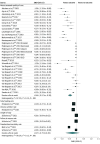Nurse Burnout and Patient Safety, Satisfaction, and Quality of Care: A Systematic Review and Meta-Analysis
- PMID: 39499515
- PMCID: PMC11539016
- DOI: 10.1001/jamanetworkopen.2024.43059
Nurse Burnout and Patient Safety, Satisfaction, and Quality of Care: A Systematic Review and Meta-Analysis
Abstract
Importance: Occupational burnout syndrome is characterized by emotional exhaustion, depersonalization, and a diminished sense of personal accomplishment and is prevalent among nurses. Although previous meta-analyses have explored the correlates of nurse burnout, none have estimated their association with health care quality and safety and patient morbidity and mortality.
Objective: To evaluate the magnitude and moderators of the association between nurse burnout and patient safety, patient satisfaction, and quality of care.
Data source: The Web of Science, Scopus, MEDLINE, Embase, PsycINFO, CINAHL, and ProQuest databases were searched from January 1, 1994, to February 29, 2024.
Study selection: Two reviewers independently identified studies that reported a quantifiable association between nurse burnout and any of the outcomes of patient safety, patient satisfaction, or quality of health care.
Data extraction and synthesis: The PRISMA 2020 guideline was followed. Two reviewers independently extracted the standardized mean difference (SMD) (Cohen d) estimates for a random-effects meta-analysis. Subgroup analyses and meta-regressions were conducted using prespecified variables.
Main outcomes and measures: Any measure of patient safety, patient satisfaction, or quality of health care previously associated with nurse burnout.
Results: A total of 85 studies (81 cross-sectional and 4 longitudinal) involving 288 581 nurses from 32 countries (mean [SD] age, 33.9 (2.1) years; 82.7% female; mean [SD] burnout prevalence rate with study-specific ascertainments, 30.7% [9.7%]) were included. Nurse burnout was associated with a lower safety climate or culture (SMD, -0.68; 95% CI, -0.83 to -0.54), lower safety grade (SMD, -0.53; 95% CI, -0.72 to -0.34), and more frequent nosocomial infections (SMD, -0.20; 95% CI, -0.36 to -0.04), patient falls (SMD, -0.12; 95% CI, -0.22 to -0.03), medication errors (SMD, -0.30; 95% CI, -0.48 to -0.11), adverse events or patient safety incidents (SMD, -0.42; 95% CI, -0.76 to -0.07), and missed care or care left undone (SMD, -0.58; 95% CI, -0.91 to -0.26) but not with the frequency of pressure ulcers. Nurse burnout was also associated with lower patient satisfaction ratings (SMD, -0.51; 95% CI, -0.86 to -0.17) but not with the frequencies of patient complaints or patient abuse. Finally, nurse burnout was associated with lower nurse-assessed quality of care (SMD, -0.44; 95% CI, -0.57 to -0.30) but not with standardized mortality rate. The associations were consistent across nurses' age, sex, work experience, and geography and persistent over time. For patient safety outcomes, the association was smaller for the low personal accomplishment subcomponent of burnout than for emotional exhaustion or depersonalization, as well as for nurses with a college education.
Conclusions and relevance: In this systematic review and meta-analysis, nurse burnout was found to be associated with lower health care quality and safety and lower patient satisfaction. This association was consistent across nurse and study characteristics.
Conflict of interest statement
Figures





References
Publication types
MeSH terms
LinkOut - more resources
Full Text Sources
Medical

